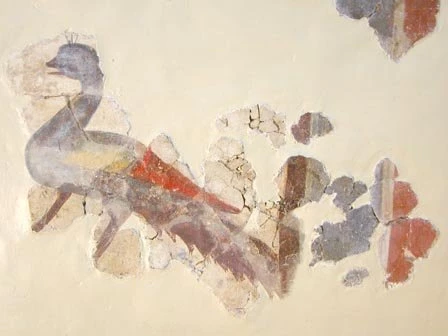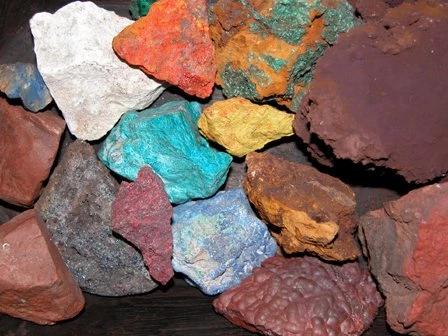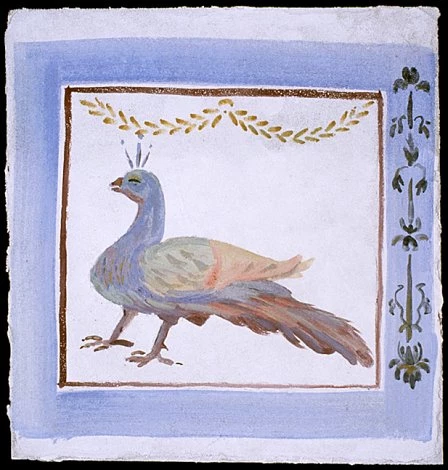Roman Caerwent's painted peacock
The Caerwent peacock. Many colours have been used to create the peacock - blues, yellows, greens and reds of varying shades.
Excavation at the Roman fortress of Caerleon, 10km (6 miles) from Caerwent, has revealed a range of original pigments. These include red and yellow ochre, as well as a pellet of the rare Egyptian blue.
A selection of natural minerals used by the Romans to make pigments. These illustrate the vibrancy of colours available to the Roman wall painters.
This reconstruction of the peacock shows how it might have looked when first painted. The pigment is applied to the plaster when it is still wet, becoming fixed to the wall as it dried. This technique is known as fresco painting.
Study of a fragile wall painting from Caerwent has revealed some of the influences Romans brought to the lives of native Britons.
The Roman conquest brought parts of Wales into contact with the style and sophistication of Imperial Rome. For wealthy Britons this contact offered a chance to share in the lifestyle of the invaders. For craftsmen it offered the prospect of new patrons and greater profits.
In the Roman world it was common for the wealthy to have the walls and sometimes the ceilings of their rooms painted with brightly coloured panels, floral motifs, or scenes from mythology. But, before the Roman conquest, wall painting in this style was unknown in Britain - here was a new craft, and one that appears to have been quickly seized upon.
It is in the Roman town of Caerwent that we have some of our best evidence for the work of the wall painters.
One piece that has attracted particular interest is a painting of a peacock from a late 3rd century AD house at Caerwent excavated in the 1980s.
Enough fragments of the peacock have survived to allow its original appearance to be recreated. It would have been painted as a fresco, that is while the plaster was still wet, the colours becoming bonded into the surface as it dried. Many colours have been used to create the peacock - blues, yellows, greens and reds of varying shades. The picture itself is on a white background within a blue frame.
While the peacock is itself a work of art, it is the pigments from which it was produced that tell us most about the wide cultural and trade contacts of Roman Britain.
For example, the blue pigment is an artificial colour first developed in Egypt but then manufactured in Italy, where a wealthy businessman set up production in the 1st century BC. It was made from heating together a mixture of sand, natron and copper, and was sold around the empire in the form of small balls to be ground up by the painter as required.
The bright red in the picture is cinnabar or vermillion (mercuric sulphide) mined in Sisapo, Spain and distributed from Rome. Trade in the pigment was so lucrative that the government had to fix its price to stop it rising. It has only been identified on 20-30 sites in Britain - an indication of its rarity.
Not all the pigments were imported from overseas - some of the red ochre in the peacock was probably mined locally, possibly in the Forest of Dean. However, the presence of the exotic pigments demonstrates a lot more than just artistic taste. They would have been a statement to anyone who visited the house with the painted peacock, that its owners were both aware of and able to afford the luxuries that came with a place in the Roman Empire.
Background Reading
Caerwent Roman Town by R. J. Brewer, Published by Cadw (2006)
Wall-painting in Roman Britain by N. Davey and R. Ling. Published by the Society for the Promotion of Roman Studies (1981).



